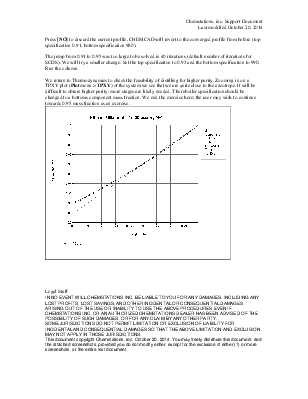




Column Models in CHEMCAD
There are three steady state distillation models in CHEMCAD: TOWR (Inside-out method), SCDS (simultaneous correction distillation), and TPLS (TOWR unit with additional in / out connections). The liquid-liquid extractor (EXTR) is a modified form of the SCDS column, as the mathematics are similar.In general, the SCDS/EXTR column is better suited to activity coefficient K values and the TOWR is better suited to equations of state.
Difficulties with columns
Inappropiate thermodynamic selection
Inappropiate column specification
Rigid contstraints for convergence
While trying to converge a column it is interesting to see why the model is failing. To see the results of the iterations that failed, follow these steps.
· In CHEMCAD, go to th RUN menu.
· Choose Convergence.
· In the convergence dialog, checkmark Display Trace Window and Generate Run History.
The first setting activates a display window which contains information on the current status of calculations when CHEMCAD runs. The latter checkmark prevents this window from being refreshed with each unit / iteration. For a column, the trace window will show the predicted composition profile from each iteration, and the error (relative to previous iteration) term. Often this information helps identify a problem. For example, if a stage is drying up, either you have too much heat or too high a vapor flow in the column.
Thermodynamics
Separation units are highly dependent on the selection of vapor liquid equilibrium (VLE) K value model. The user will remember that K value models are used to calculate the composition of the liquid and vapor phases of a mixture at a given temperature and pressure. There are several different K models which are designed for different chemical systems.
Example: Figures 1 and 2 are x vs y plots of the system water – ethanol using NRTL and SRK, respectively. There is a significant difference between the separations you will obtain in a model using these two models. For this system, NRTL would be a reasonable choice while SRK would be unrealistic. Quite often you will not be able to run a column model if you have an unrealistic thermodynamic selection.


Figure 1 Figure 2
Column Specification
Stage numbering convention in CHEMCAD is top to bottom, 1 to N. A stage is considered the space above a plate.If a condenser is present it is stage 1; if a reboiler is present it is stage N. To model a column which has ten stages plus condenser and reboiler one must specify 12 stages in CHEMCAD (10+condenser+reboiler=12).
If a condenser is present, the feed must not enter stage 1, as that is the reboiler. Top stage feeds should enter stage 2, the top stage (plate), if a condenser is present. Likewise, if a reboiler is present a bottom plate feed is connected to stage (N-1), not stage N.
Converging to Rigid Constraints
Typically the user has a specification to which they wish to desire a column. Quite often this is a restrictive composition, such as mass fraction of a key component in either the bottoms or tops.
Converging a column model in CHEMCAD is similar to converging a column in the real world; it is difficult to go directly to high purity separation. It is best to start with an easy target, such as reflux ratio and bottoms flowrate. Once the column is converged to this simple specification, we ‘tighten’ the specifications toward the goal.
Procedure for Converging from loose specifications: (see example, below
Уважаемый посетитель!
Чтобы распечатать файл, скачайте его (в формате Word).
Ссылка на скачивание - внизу страницы.